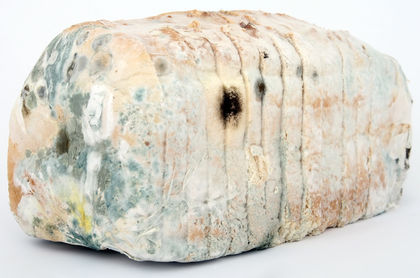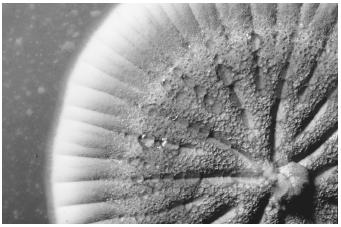Penicillin

Penicillin was discovered accidentally in 1929 when Sir Alexander Fleming observed bacterial cultures contaminated with a mold that inhibited bacterial growth. The antibiotic penicillin was subsequently isolated from cultures of the Penicillium mold. In 1938 two other British scientists, Howard

Florey and Ernst Chain, first used purified preparations of penicillin to treat bacterial infections. Penicillin may have been present in folk remedies used as early as 600 B.C.E. , at around which time molded soybean curd was used by the Chinese to treat boils and carbuncles, and moldy cheese was used by Chinese and Ukrainian peasants to treat infected wounds.
Initially it was thought that penicillin was a pure substance, but further studies revealed that a number of closely related compounds were present in Penicillium cultures. Naturally occurring penicillins, such as penicillin G, are most effective against gram-positive bacteria, but much less effective against gram-negative bacteria. A further limitation to the use of Penicillin G is that it is not well absorbed when administered orally. Research programs to produce chemically modified penicillins with improved properties have resulted in a large number of clinically useful penicillin derivatives. Examples of such penicillin derivatives include ampicillin and amoxicillin, which have much greater efficacy against gram-negative bacteria than penicillin, retain good activity against gram-positive bacteria, and are well absorbed when administered orally. The principal adverse reaction associated with the penicillins is the occurrence of allergic response.
The molecular targets for the antibacterial activity of the penicillin and related β -lactam antibiotics such as the cephalosporins are a group of bacterial enzymes known as penicillin-binding proteins (PBPs). The PBPs are essential to the final stages of bacterial cell wall biosynthesis . Penicillin and other β -lactam antibiotics inhibit PBPs, thereby inhibiting bacterial cell wall biosynthesis, which eventually results in bacterial cell lysis . (Vancomycin and cycloserine are nonpenicillin antibiotics that also inhibit bacterial cell wall biosynthesis through other mechanisms.)
The penicillins and related antibiotics have been among the most widely used therapeutic agents since their introduction into clinical practice in the 1940s. However, the widespread use of these antibiotics has resulted in the emergence and spread of bacteria that are resistant to these agents. A major mechanism of resistance to the penicillin and other β -lactam antibiotics is the bacterial production of β -lactamases, enzymes that cleave the β -lactam antibiotics and render them inactive before they can inhibit their PBP targets. Significant efforts have been made to develop β -lactam antibiotics resistant to the β -lactamases, and toward finding inhibitors of the β -lactamases to allow β -lactam antibiotics to be useful antibacterial agents against β -lactamase producing bacteria.
GRAM-POSITIVE AND GRAM-NEGATIVE BACTERIA
Bacteria can be broadly classified into two groups; the gram-positive bacteria, which are stained purple after the gram staining procedure, and the gram-negative bacteria, which are stained red. The difference in staining reflects differences in the structure of the cell walls between gram-positive and gram-negative bacteria. Pathogenic gram-positive bacteria include Staphylococcus aureus and Bacillus anthracis, and pathogenic gram-negative bacteria include Escherichia coli and Neisseria gonorrhoeae.
SEE ALSO Antibiotics ; Enzymes ; Fleming, Alexander ; Inhibitors .
William G. Gutheil
Bibliography
Mandell, Gerald L., and Petri, William A. (1996). "Antimicrobial Agents: Penicillins, Cephalosporins, and Other β -Lactam Antibiotics." In Goodman & Gilman's Pharmacological Basis of Therapeutics, 9th edition, ed. Joel G. Hardman and Lee E. Limbird. New York: McGraw-Hill.
Nicolaou, K. C., and Boddy, Christopher N. C. (2001). "Behind Enemy Lines." Scientific American 284(5):54–61.
Comment about this article, ask questions, or add new information about this topic: